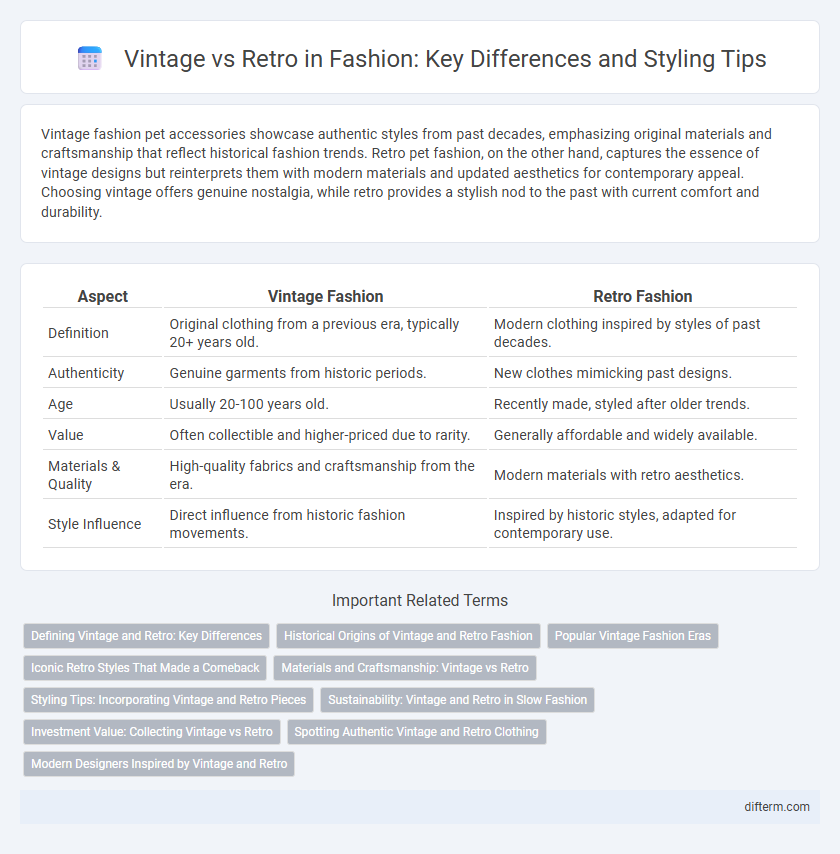Vintage fashion pet accessories showcase authentic styles from past decades, emphasizing original materials and craftsmanship that reflect historical fashion trends. Retro pet fashion, on the other hand, captures the essence of vintage designs but reinterprets them with modern materials and updated aesthetics for contemporary appeal. Choosing vintage offers genuine nostalgia, while retro provides a stylish nod to the past with current comfort and durability.
Table of Comparison
| Aspect | Vintage Fashion | Retro Fashion |
|---|---|---|
| Definition | Original clothing from a previous era, typically 20+ years old. | Modern clothing inspired by styles of past decades. |
| Authenticity | Genuine garments from historic periods. | New clothes mimicking past designs. |
| Age | Usually 20-100 years old. | Recently made, styled after older trends. |
| Value | Often collectible and higher-priced due to rarity. | Generally affordable and widely available. |
| Materials & Quality | High-quality fabrics and craftsmanship from the era. | Modern materials with retro aesthetics. |
| Style Influence | Direct influence from historic fashion movements. | Inspired by historic styles, adapted for contemporary use. |
Defining Vintage and Retro: Key Differences
Vintage fashion refers to authentic clothing and accessories originating from a specific era, typically at least 20 to 30 years old, showcasing genuine period characteristics and craftsmanship. Retro fashion mimics or is inspired by styles from previous decades but is often newly made, emphasizing nostalgic appeal rather than historical authenticity. The key difference lies in vintage representing original, dated pieces, while retro captures the essence and aesthetics of past trends through modern recreations.
Historical Origins of Vintage and Retro Fashion
Vintage fashion refers to clothing and accessories that are authentically from a previous era, typically at least 20 to 30 years old, showcasing genuine historical styles and craftsmanship from specific decades such as the 1920s flapper dresses or 1950s rockabilly looks. Retro fashion, on the other hand, is characterized by contemporary pieces designed to imitate or evoke the style and aesthetic of past periods, often blending modern trends with iconic elements from the 1960s or 1980s. The distinction lies in vintage being original artifacts of history, while retro represents a nostalgic reinterpretation or revival of historical fashion trends.
Popular Vintage Fashion Eras
Popular vintage fashion eras include the Roaring Twenties with its flapper dresses and art deco influences, the 1950s characterized by full skirts and pin-up styles, and the 1970s known for bohemian prints and disco glamour. Each era reflects distinct cultural and social trends that inspire contemporary designers and collectors. Vintage fashion pieces from these periods remain highly sought after for their timeless appeal and craftsmanship.
Iconic Retro Styles That Made a Comeback
Iconic retro styles such as tie-dye, high-waisted jeans, and oversized blazers have made a significant comeback in contemporary fashion, blending nostalgia with modern trends. These vintage-inspired pieces from the '70s, '80s, and '90s reemerge on runways and streetwear, driven by a growing appreciation for sustainable and timeless aesthetics. Retro accessories like cat-eye sunglasses and scrunchies further amplify the revival, reinforcing the cyclical nature of fashion inspiration.
Materials and Craftsmanship: Vintage vs Retro
Vintage fashion features materials like natural fibers--cotton, wool, and silk--crafted with meticulous hand-sewing and traditional tailoring techniques that emphasize durability and unique detailing. Retro fashion uses modern synthetic fabrics and machine-made production methods, replicating vintage aesthetics while prioritizing affordability and mass production. The difference in craftsmanship reflects vintage's focus on artisanal quality versus retro's emphasis on accessibility and trend-driven design.
Styling Tips: Incorporating Vintage and Retro Pieces
Incorporate vintage pieces by mixing classic, authentic garments from the 1920s to 1980s with modern basics to create unique, timeless outfits. Use retro elements, inspired by past decades' trends, as statement accessories or bold prints to add playful, nostalgic flair without overwhelming your look. Balance proportions by pairing oversized vintage jackets with slim-fit pants or high-waisted skirts with contemporary tops for a flattering silhouette.
Sustainability: Vintage and Retro in Slow Fashion
Vintage and retro fashion significantly contribute to sustainability by promoting slow fashion principles that reduce waste and resource consumption. Vintage pieces, often over 20 years old, offer unique, high-quality garments that encourage reuse, while retro styles revive classic trends with modern sustainable materials and ethical production. Embracing vintage and retro fashion supports a circular economy, minimizing environmental impact compared to fast fashion's rapid turnover.
Investment Value: Collecting Vintage vs Retro
Vintage fashion pieces, typically over 20 years old and often from renowned designers, tend to hold or appreciate in investment value due to their rarity and historical significance. Retro clothing, inspired by past styles but newly produced, generally lacks the same long-term financial appreciation and is more accessible for everyday wear. Collectors prioritize vintage items for their authenticity and potential to increase in market value, making them a more strategic investment compared to retro fashion.
Spotting Authentic Vintage and Retro Clothing
Spotting authentic vintage clothing involves examining fabric quality, stitching techniques, and wear patterns consistent with the era, often dating from 1920s to 1980s. Retro clothing, inspired by past styles but produced more recently, typically features modern labels and materials that mimic vintage aesthetics without the natural aging signs. Identifying authenticity requires attention to details such as original brand tags, unique hardware, and historical fashion elements specific to the decade.
Modern Designers Inspired by Vintage and Retro
Modern designers draw heavily from vintage and retro aesthetics, incorporating classic silhouettes, fabrics, and patterns into contemporary collections. Brands like Gucci and Prada often reinterpret 1950s and 1970s styles, blending nostalgic elements with modern tailoring and sustainable materials. This fusion of eras appeals to consumers seeking timeless elegance combined with current fashion innovation.
vintage vs retro Infographic

 difterm.com
difterm.com